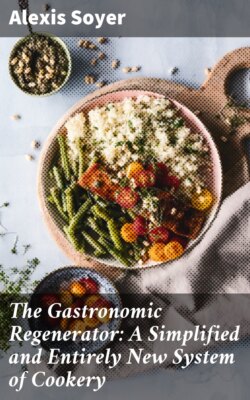Читать книгу The Gastronomic Regenerator: A Simplified and Entirely New System of Cookery - Soyer Alexis - Страница 10
На сайте Литреса книга снята с продажи.
CARVING OF POULTRY.
ОглавлениеTable of Contents
A fowl which has been prepared with the Tendon Separator before roasting, can produce afterwards ten very inviting pieces, suitable to the fancy of as many guests.
In the first place you take a carving fork, which you stick in the breast, between figs. 5 and 6, then you give a cut at the fillet, beginning at 1 down to 2, where you make the point of the knife cut through the joint of the wing, which by twisting a little will easily come asunder. The same operation is done from 3 to 4; and without removing the fork, you slide the knife under the leg at 7, and the same at 8, and both legs will immediately separate. The next cut is to be given at 5 to 6, and afterwards the back is divided in the same direction as the last numbers—as each leg is divided at the joint commonly called drumstick, it completes the ten parts.
A Duck. The best part of a duck is the breast, which should be cut in fillets obliquely, then the wings and the legs, the same as the fowl, and the body in two.
A Pheasant. The best parts are the breast and legs, which are carved the same as a fowl.
A Partridge. The wings and the body are the best parts.
A roast Hare must be cut along the spine, from the neck downwards to obtain the fillets, which ought then to be divided in parts, in the same oblique direction as the ribs. The legs and shoulders are seldom carved, but they are, with the body, excellent in a hash or stewed.
